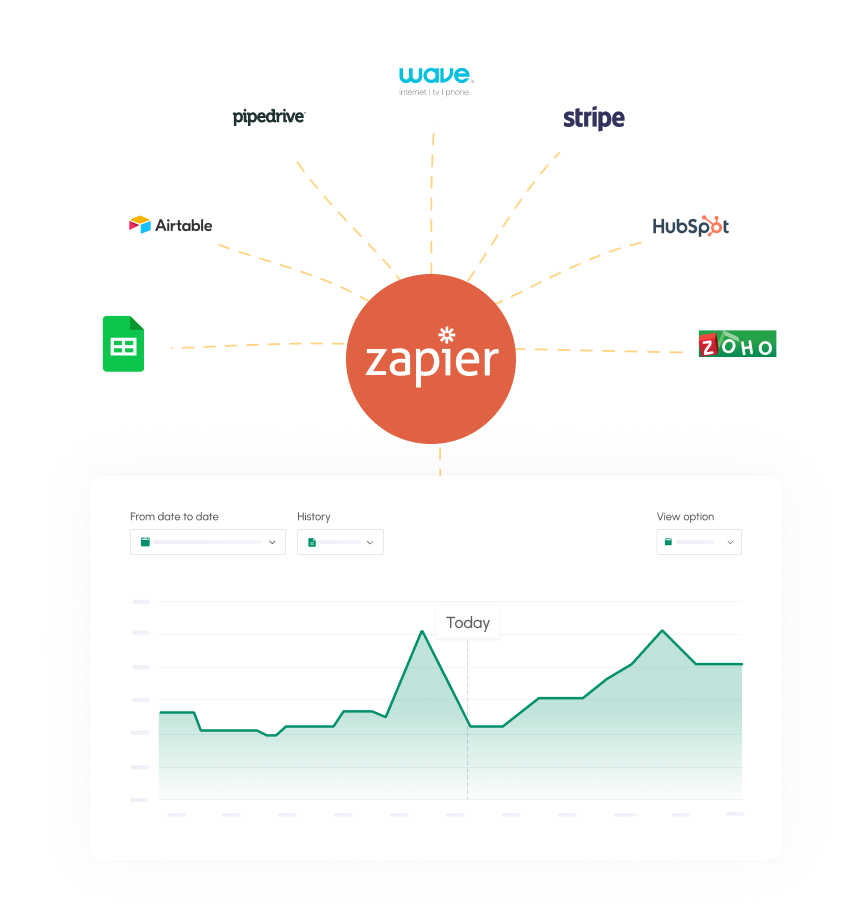
Sales forecasting isn’t just for large enterprises: every business can benefit from these forecasts. If you think that your small company or startup can’t benefit from forecasting, we’re going to show you the importance of running your own forecasts.
Introduction to Sales Forecasting
What is a sales forecast?
It's a prediction of how many sales you’ll make over a pre-defined period. For example, public companies often create sales forecasts for the coming quarter and year. Smaller businesses can benefit from having short-term forecasts that may be as short as one week.
Why?
They'll be able to better prepare for the sales ahead, whether that means:
- Hiring people during a sales rush
- Laying people off when weak sales are projected
A consistent sales forecast definition would be: a process to estimate the sale of a product or service over a specified period of time.
Benefits of Accurate Sales Forecasting
Accurate sales forecasting is challenging for many businesses, but when your forecasting method is accurate – or close to it – you'll benefit in many ways:
- Increase your chance of hitting sales targets. Reaching sales targets is easier when you have forecasts in place. One survey found that 97% of companies hit their goals when they had forecasts. Why? No data was provided. However, it can be hypothesized that the sales team worked harder to hit the forecasted figures.
- Aids in decision-making. Data-backed decisions are often sound and better help a business grow. Sales forecasts allow leaders to make pertinent decisions based on the potential sales of the company. Funding can be sought for slow sales periods or workers hired if there’s an influx of sales.
- Strategic planning. Scenarios and strategic planning can be put in place when you run sales forecasts. You'll have the opportunity to correct potential sales slumps and find ways to better manage cash flow.
- Identify industry trends. Is one product or service no longer selling well? If so, you can spot this trend and perhaps funnel more money into advertising or discontinue the item if the market appetite has shifted away from it.
Utilizing forecasting means being better prepared for the future. It's unlikely that your forecast will be 100% accurate, but it can help you develop contingency plans for periods of growing or declining sales.
Common Methods for Sales Forecasting
Forecasting sales can be done using multiple methods, but many companies are using software to run the calculations. However, some of the most common methods when creating forecasts are:
- Trend analysis: Business sales go through trends. Sometimes called historical analysis, this form of forecasting will analyze all of your past sales to spot seasonal trends, such as sales rising in December and falling in February. Analysis can also include target market information and location.
- Regression analysis: Through regression analysis, a sales team utilizes past performance data to help predict what would happen between two variables, such as one marketing method and its ability to generate sales.
- Time series analysis: A common form of sales forecasting involves time series analysis. Using this method, data is analyzed at different intervals and tracked over time to learn how it changes.
- Causal analysis: This form of forecasting involves analyzing the current market, understanding influences that may impact sales and adding variables that can change the course of sales during the reporting period.
Utilizing consistent forecasting models will allow you to track the accuracy of forecasts.
Real-life Sales Forecasting Examples
Below are examples using multiple sales forecasting methods:
Creating an Effective Sales Forecast Template
Creating a sales forecast template can help simplify the forecasting process. Spreadsheets and software tools are available that can help you create templates.
First, frame out the template by outlining:
- What you’re forecasting
- Your goals
- The time periods you’re covering
- Your most important KPIs
Looking at a sales forecasting example can help you with creating your own template.
Best Practices for Strategic Sales Forecasting
When it comes to sales forecasting, it’s important to follow the best practices to ensure they’re reliable and accurate.
Use Historical Data
If you have an established business, use historical data to create your forecasts. If you have a new business or haven’t implemented analytics or other forms of data tracking, now is the time to start.
Understanding your past will help you understand where you’re headed.
Historical data isn't always an accurate prediction of the future, but it can serve as a solid foundation for your forecasts.
Use a Simple Model
It's tempting to use a variety of sales forecasting models, but try to resist this temptation. Instead, start with a simple model and improve it over time.
The fewer variables you have to keep track of, the better. Why? Because it will be easier to:
- Achieve your sales goals
- Secure approval from leadership on your sales forecast
If you start with a simple model, you can build on it slowly over time.
Don’t Forget Seasonality
If your business has high and low seasons, don’t forget to incorporate that into your forecasting model.
If your forecast is linear, you will lose some accuracy and reliability due to seasonality or other factors.
Consider Market Trends and Your Competitors
Sales are affected by more than internal factors, like your sales team. There are many external factors and variables that are market-related that will affect your sales and, ultimately, your forecasts.
Let’s say that you have two products – one that is new and trendy and another that is a steady staple in your lineup. These two products should have separate segments because their growth trajectories would also be different.
Competition is another consideration. If you have a competitor that has similar offerings and decides to lower their price, this will undoubtedly affect your sales.
Keeping a pulse on the market is important, as you can take these factors into account and create more accurate sales forecasts.
Consider “What If” Scenarios
Creating “what if” scenarios will allow you to look at your business from different perspectives and gain new insights.
These scenarios can help you with building sales forecasts.
Tools and Software for Sales Forecasting
Tools and software can help simplify and streamline sales forecast modeling. These tools connect with your accounting software and use that data to create forecasts automatically.
One big advantage of using tools and software is that they reduce the risk of error because all of the data comes directly from your bank account.
A wide range of solutions are available to help make sales forecasting as simple and easy as possible.
Conclusion
Sales forecasting plays an important role in running a business. It helps you understand whether you will have the funds to carry out your plans, hire new staff or have the ability to expand your operations.
Tools and software can help automate the process and virtually eliminate the risk of error.
Related posts:
You may be interested:
New:











